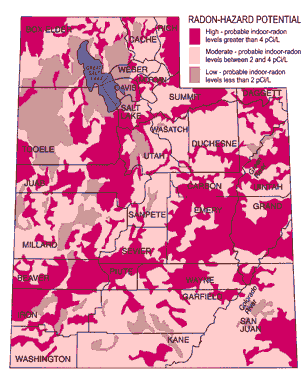Radon in Utah
What Is Radon?
Radon is an odorless, colorless, and tasteless naturally occurring radioactive gas that is in the air you breathe and the water you use for drinking, bathing and cooking. At high levels it is a serious health hazard (it is the leading cause of lung cancer in nonsmokers). The EPA recommends fixing homes with radon levels that are measured at 4.0pCi/L and higher. The most successful radon reduction method is the installation of a radon mitigation system using a technique known as active soil depressurization. A radon mitigation system draws the radon gas from beneath your home and safely vents it above the roofline, reducing the radon level. Like many household systems - but even more so since it involves the removal of a radioactive gas - it is best to leave it to a radon professional to install.

Radon In Utah
Radon is the leading cause of lung cancer for nonsmokers and it can be found with elevated levels in nearly every state, including Utah. In fact, The Utah Department of Environmental Quality Division of Radiation Control reported as of April 2018 that 37% of short-term radon test results in Utah were above the EPA recommended level of 4.0 pCI/L. The Utah Radon Coalition estimated in 2016 that over 220 people in Utah were diagnosed with radon-induced lung cancer. Sadly, 21,000 people die every year of radon-induced lung cancer in the United States alone. The good news, however, is that radon is an easy and fairly inexpensive issue to fix. It’s well worth the time and effort to test your home for radon to make sure it’s radon-safe, than to risk the health of those in your household.
Radon Levels In Utah
Maps show that high radon levels (above the EPA recommended 4.0 pCi/L) are more commonly found in some areas in Utah; however, high test results can be found throughout the state. EPA says that all homes should be tested, regardless of map designations. Click here to view Utah's State Radon Map or refer to image shown on the right-hand side. 
• Carbon
• Duchesne
• Grand
• Piute
• Sanpete
• Sevier
• Uintah
How Does Radon Enter Your Home
Radon gas can enter both old and new homes, regardless if there are visible cracks or not. In fact, your neighbor’s brand new home could have radon levels exceeding 4pCi/L while yours is 2.7pCi/L or vice versa. Homes which sit side-by-side can have completely different radon levels, so it’s critical to test every home for radon, regardless of their location or proximity to a house that is deemed radon-safe. If you live within one of these Utah counties, make sure to test your home for radon and take the proper course of action if the results are at 4pCi/L or higher. Radon enters the home through:
• Crawlspaces
• Cracks in the foundation and walls
• Floor drains
• Pipes
• Sump pumps
How To Make Your Home Radon Safe
You can’t possibly know if your home is radon-safe unless you test it. If your radon test result is between 2.0 and 4.0 pCi/L, you might want to consider performing a second, long-term radon test to confirm the results. If your radon test result is 4.0pCi/L or higher, you should take action and contact a radon professional to get a radon mitigation system installed. Click Here to find a radon professional in Utah or your surrounding area.
Regardless of your radon test results (high or low), it is recommended to re-test your home every 2 years to make sure your home remains as radon-safe as possible.
How To Find a Radon Professional in Utah for Radon Testing and Radon Mitigation
If you need to find a radon professional to conduct a radon test or install a radon mitigation system due to elevated levels of radon, Click Here. Our Find A Pro online tool will help identify qualified radon professionals in Utah and the surrounding area to get the job done properly.
Sources:
Utah Geological Survey. “RADON INFORMATION & RADON-HAZARD POTENTIAL MAPS”.
http://geology.utah.gov/hazards/radon/


Validate your login